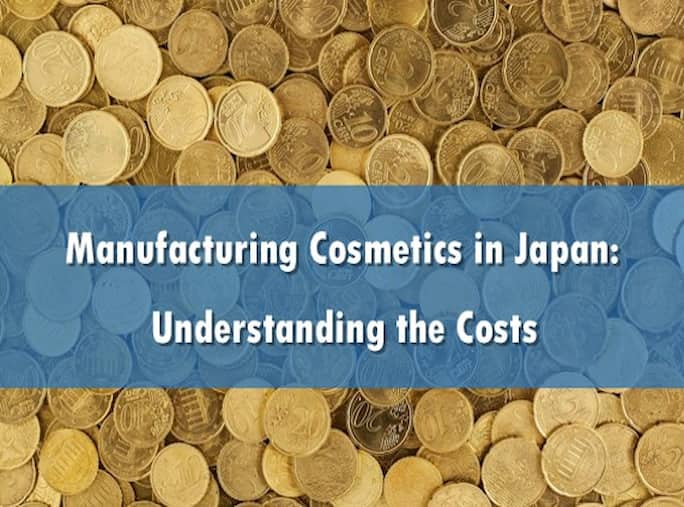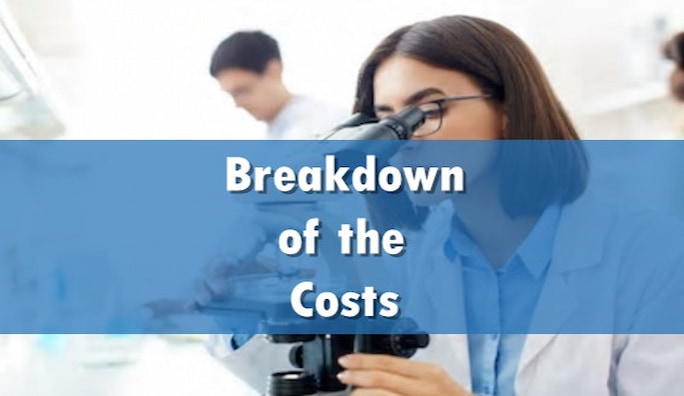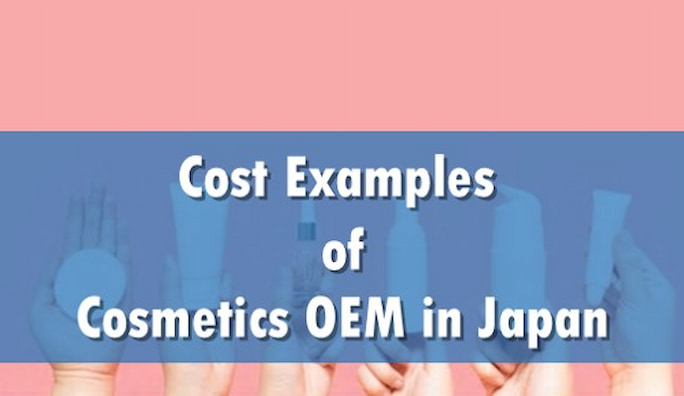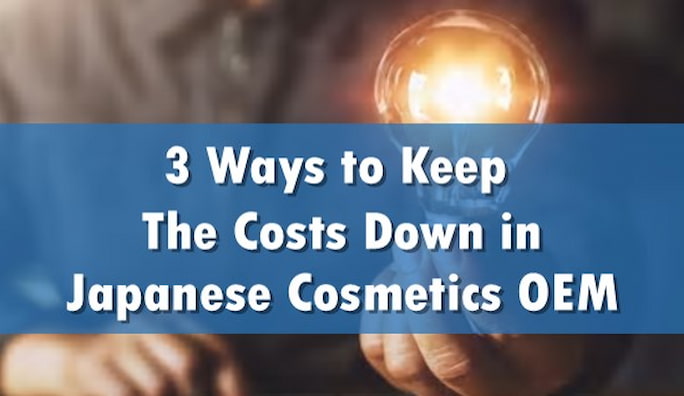
- HOME
- Cosmetic OEM Lab

Cost is the first thing to come to mind when we consider any kind of investment. When it is producing cosmetic products, one needs to consider unit price and the total amount that will be spent to start that product or business.
In the world of manufacturing, many “hidden” costs can easily be overlooked by inexperienced people. These can be a handful when the product is imported from another country.
In this article, we will explain the general costs of producing cosmetic OEM products in Japan.
Contents

We could categorize these costs into 6 different groups.
This is the first step into starting a new cosmetic product. Once parties agree on a concept, the manufacturer produces a prototype. This can be repeated multiple times in order to meet the client’s expectations regarding texture, fragrance, efficacy, and so on.
Although this depends on the product and the client, we could say that 4-5 repeats are quite common. Each prototype takes 1-2 weeks depending on the product and the manufacturer.
The R&D process and prototypes are often free of charge. However, there are situations where the manufacturer requires payment. Examples of this would be when the prototypes need to be delivered in large quantities or use ingredients that the manufacturer needs to procure.
Even though the appearance of a product plays a huge role in the impact it makes on the person who sees or touches it, it wouldn’t be wrong to assume that the most important asset of a cosmetic product is what is inside, which in this case is called “bulk”.
The cost of bulk varies based on product type. Creams are often the most expensive to produce when it comes to skincare. Lotions tend to be significantly cheaper due to containing high ratios of water but they can also be expensive with the use of expensive raw materials.
As the number and ratio of expensive raw materials increase, so does the product cost. We advise our clients to choose a certain number of ingredients that fit the concept while not bringing the price too high.
Also, when the client requires the use of a rare ingredient that the manufacturer does not possess in their inventory, it will need to be procured by either the client or the manufacturer. MOQ of raw materials can be anywhere between 100 grams and 5 kg, the average being 1kg. As the prices vary on a large scale, this also could add up to the initial costs to consider.
The most common packaging materials in cosmetics are containers, boxes, and labels. We particularly think that containers have the biggest effect on how a product looks and feels in the hand of a person.
We would like to break down the following 3 packaging materials.
There are many different types of containers in the market. The more complicated the structure is, the more expensive it gets. Products like airless containers or lipstick containers particularly tend to be quite expensive. Also, Japanese-made pomps can add quite add to the price.
Even though plastic is fundamentally cheaper than glass, it can indeed be very luxurious expensive with the addition of a couple of different processes and coatings.
Also, in case the products are printed, there will be a need to pay an initial fee for the print plates.
Not all products come in a box but it surely is a quite common practice.
They cost surprisingly more than what most people would guess. The prices are especially high at quantities of 1,000 and under and come down quite a bit at quantities of 3,000 and more. Still, they are quite more expensive in Japan than in most countries.
To bring the costs down, we recommend our clients either omit the use of the box or manufacture 3,000 in quantity. Even if the manufacturing lot is 1,000 pieces at a time, the rest of the inventory could be stored for future productions.
Of course, this is only possible for products that already have a customer base and are bound to get repeat orders.
Boxes come with initial costs such as cutting dies, print plates, prototype production, etc. These costs can be quite overwhelming especially when there are many fancy coatings are applied to the box.
Many of our clients prefer a label application over a direct print for various reasons.
In most cases, labels are applied in situations where the quantity of containers is too low to apply a print or the cost is too high.
Also, clients who have different SKUs may use the same container for different products and just change the label to bring the costs down significantly.
That being said, labels are not all about cost-saving. We do have clients who prefer labels for design-related reasons as well.
Labels come with initial costs such as cutting dies and print plates as well, however, they are significantly lower than that of boxes.
Once the bulk is produced, it has to be filled in the containers. Depending on the specifications of the product, the containers may be labeled or placed in boxes.
The more complicated a product is, the higher this cost will go up.
Once the product is ready, it will be shipped to the destination requested by the client. In Japan, it is common practice that quotations do not include the shipment, therefore, this often comes as an additional cost to consider.
However, there are cases that the shipment fee is included in the price due to the request by the client, although this only applies to domestic deliveries.
For international clients, there will be an importation process. This cost will depend on the trade terms between the seller and buyer.
In the Japanese cosmetic industry, it is mostly either EXW or FOB.
EXW means that the seller passes the product from the manufacturing facility and does not bear any costs or responsibility after that point.
FOB, on the other hand, covers the shipment fee from the manufacturing facility to the port, as well as various exportation fees on the terminal. Also, the seller bears the responsibility for the products to the point where the products are loaded on the ship or aircraft.
FOB reflects on the price at around 10-15 JPY/piece depending on the product weight etc.
In either case, the client is required to find a forwarder to take care of the export and import process, as well as the shipping and delivery of the product.
This will heavily depend on the distance and method of freight being air or sea.
Even though the client will be exempt from Japanese VAT, there will be a set of taxes and fees awaiting at the country of destination.
Unfortunately, costs do not stop there. Various documents are often required to register the product and these may account for a couple of hundreds of US dollars depending on the destination and product as well.
It is beneficial to keep in mind that manufacturers cannot provide accurate information as these fees vary from country to country.

In this section, we will be displaying examples of actual costs to manufacture cosmetics OEM products in Japan.
First, let’s take a look at lotions. Below is a display of expected costs in the case of producing a 100 ml skincare lotion.
| Quantity | 100 pcs | 1000 pcs |
| Total Cost | JPY 90,000 | JPY 600,000 |
| Unit Cost | JPY 900 | JPY 600 |
| <Cost Breakdown> | ||
| Bulk | JPY 490 | JPY 370 |
| Plastic Container | JPY 160 | JPY 130 |
| Label | JPY 90 | Unneeded |
| Box | JPY 160 | JPY 100 |
Below are the expected costs in the case of an 80 ml serum.
| Quantity | 100 pcs | 1000 pcs |
| Total Cost | JPY 100,000 | JPY 650,000 |
| Unit Cost | JPY 1000 | JPY 650 |
| <Cost Breakdown> | ||
| Bulk | JPY 550 | JPY 380 |
| Plastic Container | JPY 200 | JPY 170 |
| Label | JPY 100 | Unneeded |
| Box | JPY 150 | JPY 100 |
Face masks are one of the top categories we get inquiries about.
| Quantity | 3,000 qty | 10,000 qty |
| Total Cost | JPY 450,000 | JPY 1,150,000 |
| Unit Cost | JPY 150 | JPY 115 |
| <Cost Breakdown> | ||
| Bulk | JPY 80 | JPY 55 |
| Printed Sachet | JPY 70 | JPY 60 |
As much as this is obvious, the price goes down as quantity goes up. Quantities such as 100 pieces are a little bit extreme but it is done, even though for the exclusively domestic market.
Price differences between 1,000 pieces and 3,000 pieces are also as apparent.

Producing cosmetics OEM products in Japan is without any question, expensive. However, there are still effective ways to bring the costs down.
We would like to talk about 3 proven ways of doing so.
Changing a formulation that already exists is a lot faster and often cheaper than creating an original one.
Even though this sounds unsatisfying, using these formulations as a base and adding original ingredients as well as arranging the texture, etc., often results in an entirely different product.
It is a fact that packaging materials account for more than half of the total cost. When luxurious materials are used, this can go up to 80% of the total cost.
It becomes vital to choose reasonable and economical materials to keep the costs sustainable, especially when the production quantity is low.
We often encounter clients who want to throw everything they can think of in one product. A high number of expensive ingredients at high concentrations and luxurious packaging at the same time.
However, there are a lot of unknowns in any investment, and reality can be disappointing. It is important to have the flexibility to accept reality and focus on what can be done within the budget.
We believe that every company should start with determining retail price first and then their budget calculating from there. And we also believe it is important not to cross that budget and stick to the plan as much as possible.
It is always possible to build the product around one strong point and market it effectively.

In this article, we discussed the general costs of producing cosmetic OEM products in Japan and mentioned a few key points we think are important to keep the costs at reasonable levels.
Please feel free to contact us regarding any kind of cosmetic product via the button below.
Inquiry
For further information, please contact us.